Nursing Case Study: Breast Cancer Diagnosis and Interventions
VerifiedAdded on 2020/04/01
|23
|6453
|62
Report
AI Summary
This nursing case study presents a detailed analysis of a 38-year-old female patient diagnosed with invasive ductal carcinoma (IDC) of the breast. The report begins with an overview of the patient's past medical history, assessment findings, and diagnostic process, including mammography and biopsy results. It explores the clinical manifestations of IDC, such as the formation of a breast lump, skin dimpling, and tenderness. The study identifies key health issues, including pain and anxiety, and outlines evidence-based nursing interventions to address these concerns. These interventions include non-pharmacological pain management techniques, patient education, and the provision of a supportive environment. The case study also touches upon other chronic health conditions and their associated nursing considerations. The report concludes by emphasizing the importance of compassionate, evidence-based care in improving patient outcomes and overall treatment experience for patients with chronic illnesses. The study also includes different scenarios to demonstrate how nursing care plans can be tailored to address specific patient needs and to minimize sensory perceptions.
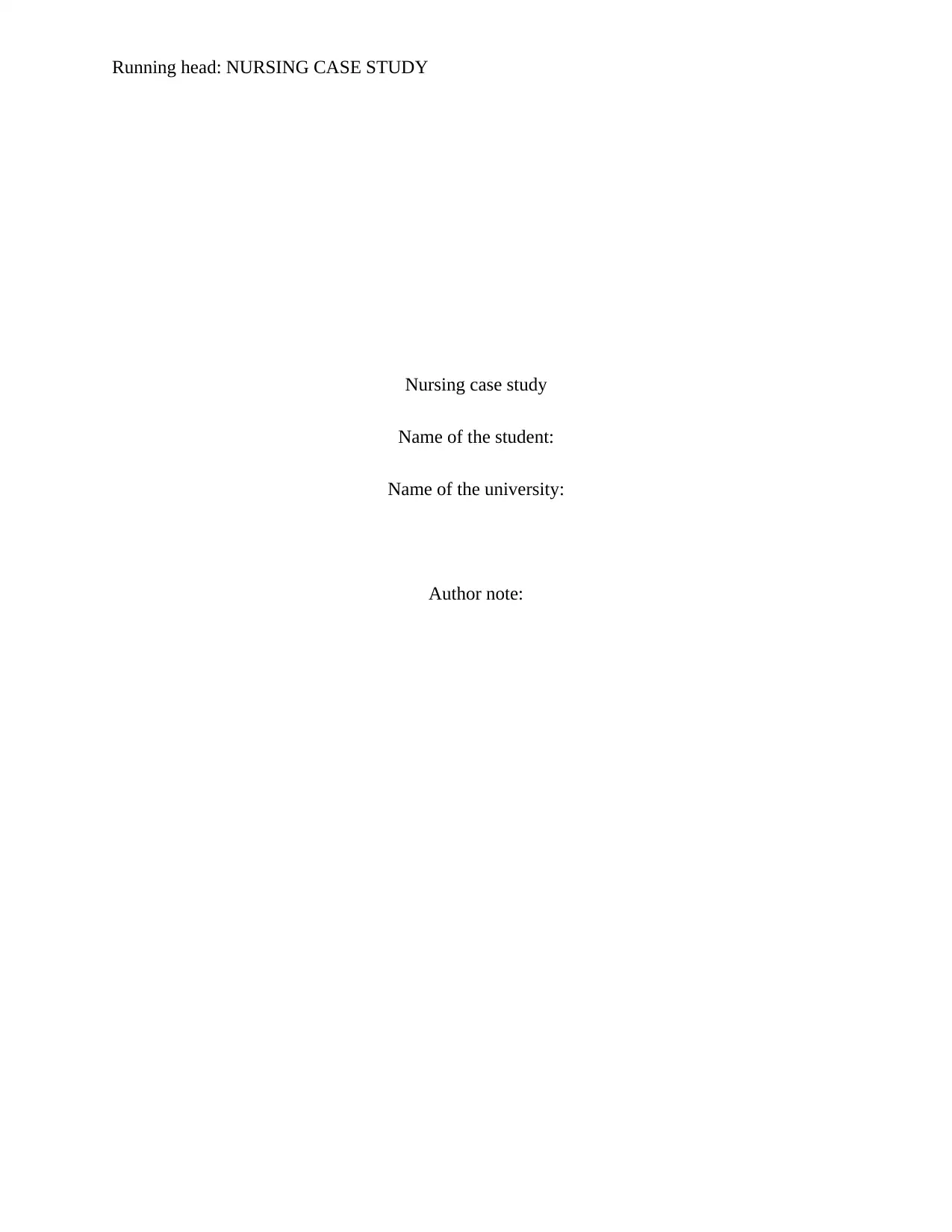
Running head: NURSING CASE STUDY
Nursing case study
Name of the student:
Name of the university:
Author note:
Nursing case study
Name of the student:
Name of the university:
Author note:
Paraphrase This Document
Need a fresh take? Get an instant paraphrase of this document with our AI Paraphraser
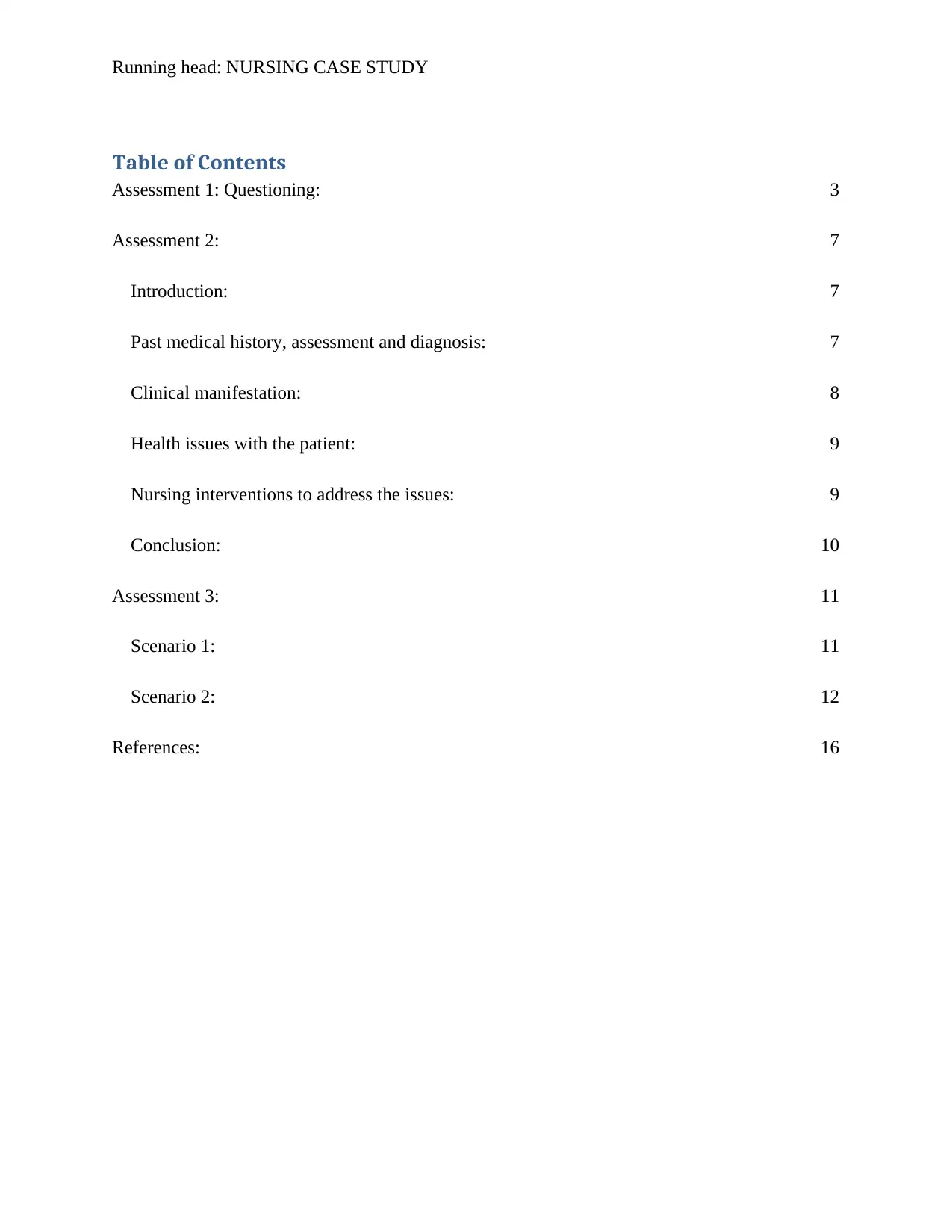
Running head: NURSING CASE STUDY
Table of Contents
Assessment 1: Questioning: 3
Assessment 2: 7
Introduction: 7
Past medical history, assessment and diagnosis: 7
Clinical manifestation: 8
Health issues with the patient: 9
Nursing interventions to address the issues: 9
Conclusion: 10
Assessment 3: 11
Scenario 1: 11
Scenario 2: 12
References: 16
Table of Contents
Assessment 1: Questioning: 3
Assessment 2: 7
Introduction: 7
Past medical history, assessment and diagnosis: 7
Clinical manifestation: 8
Health issues with the patient: 9
Nursing interventions to address the issues: 9
Conclusion: 10
Assessment 3: 11
Scenario 1: 11
Scenario 2: 12
References: 16
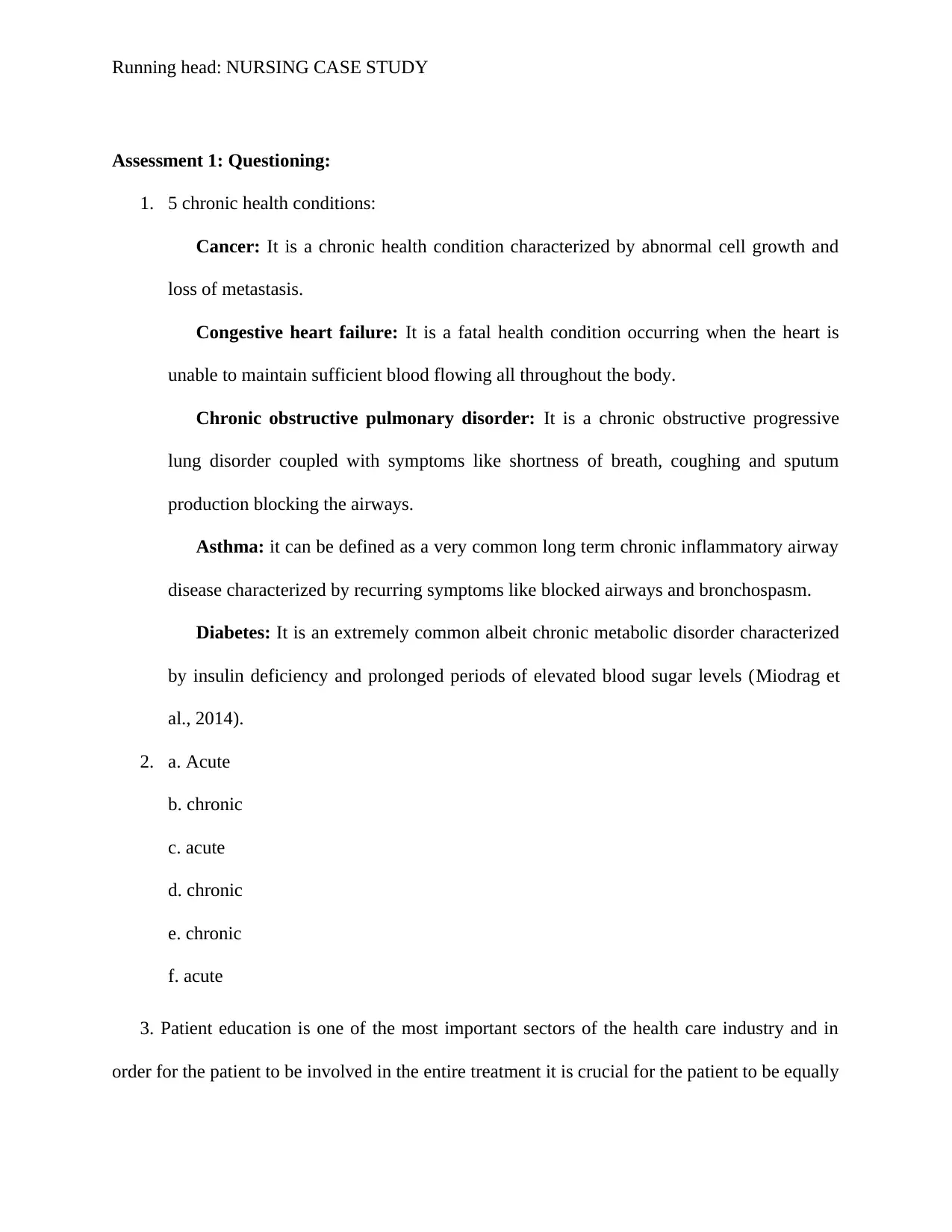
Running head: NURSING CASE STUDY
Assessment 1: Questioning:
1. 5 chronic health conditions:
Cancer: It is a chronic health condition characterized by abnormal cell growth and
loss of metastasis.
Congestive heart failure: It is a fatal health condition occurring when the heart is
unable to maintain sufficient blood flowing all throughout the body.
Chronic obstructive pulmonary disorder: It is a chronic obstructive progressive
lung disorder coupled with symptoms like shortness of breath, coughing and sputum
production blocking the airways.
Asthma: it can be defined as a very common long term chronic inflammatory airway
disease characterized by recurring symptoms like blocked airways and bronchospasm.
Diabetes: It is an extremely common albeit chronic metabolic disorder characterized
by insulin deficiency and prolonged periods of elevated blood sugar levels (Miodrag et
al., 2014).
2. a. Acute
b. chronic
c. acute
d. chronic
e. chronic
f. acute
3. Patient education is one of the most important sectors of the health care industry and in
order for the patient to be involved in the entire treatment it is crucial for the patient to be equally
Assessment 1: Questioning:
1. 5 chronic health conditions:
Cancer: It is a chronic health condition characterized by abnormal cell growth and
loss of metastasis.
Congestive heart failure: It is a fatal health condition occurring when the heart is
unable to maintain sufficient blood flowing all throughout the body.
Chronic obstructive pulmonary disorder: It is a chronic obstructive progressive
lung disorder coupled with symptoms like shortness of breath, coughing and sputum
production blocking the airways.
Asthma: it can be defined as a very common long term chronic inflammatory airway
disease characterized by recurring symptoms like blocked airways and bronchospasm.
Diabetes: It is an extremely common albeit chronic metabolic disorder characterized
by insulin deficiency and prolonged periods of elevated blood sugar levels (Miodrag et
al., 2014).
2. a. Acute
b. chronic
c. acute
d. chronic
e. chronic
f. acute
3. Patient education is one of the most important sectors of the health care industry and in
order for the patient to be involved in the entire treatment it is crucial for the patient to be equally
⊘ This is a preview!⊘
Do you want full access?
Subscribe today to unlock all pages.

Trusted by 1+ million students worldwide
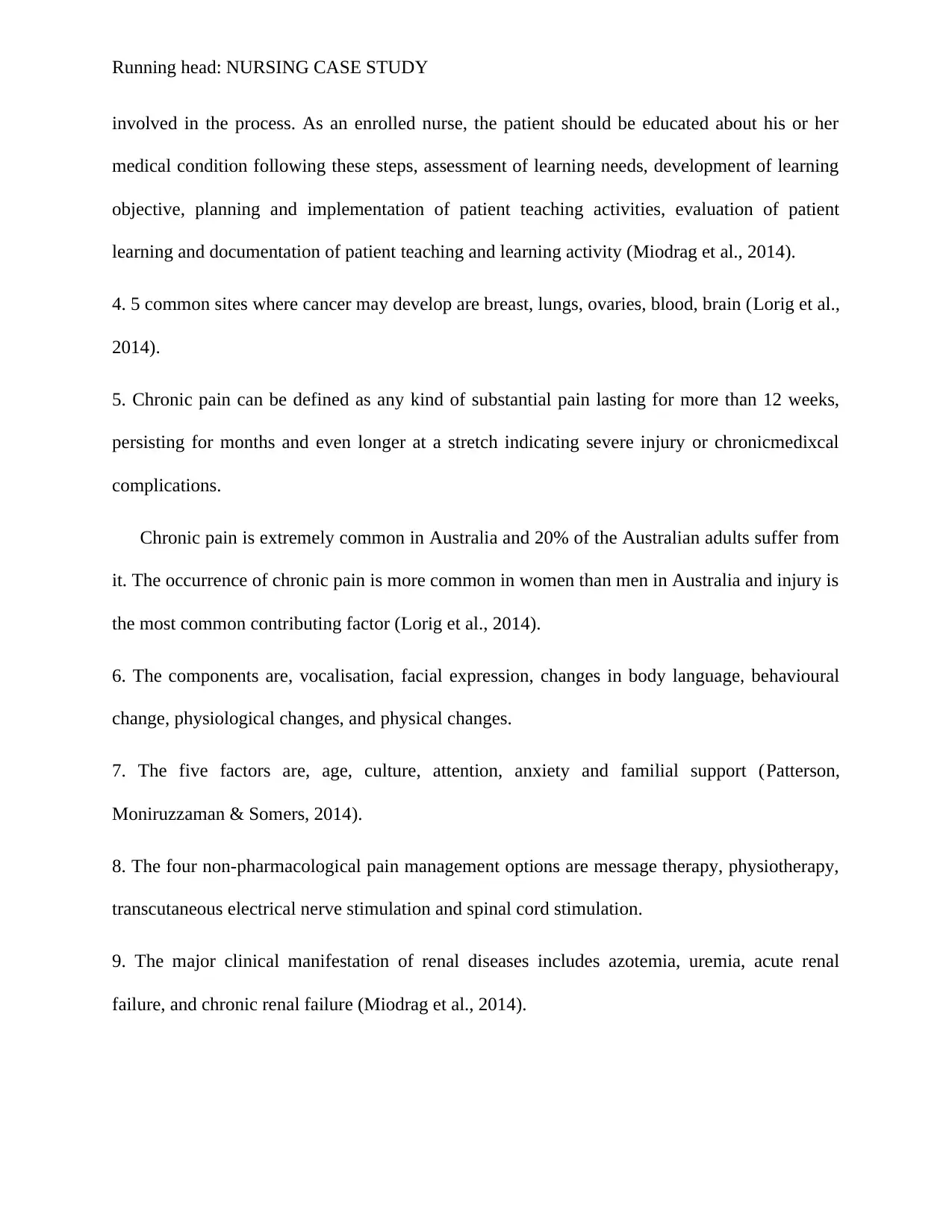
Running head: NURSING CASE STUDY
involved in the process. As an enrolled nurse, the patient should be educated about his or her
medical condition following these steps, assessment of learning needs, development of learning
objective, planning and implementation of patient teaching activities, evaluation of patient
learning and documentation of patient teaching and learning activity (Miodrag et al., 2014).
4. 5 common sites where cancer may develop are breast, lungs, ovaries, blood, brain (Lorig et al.,
2014).
5. Chronic pain can be defined as any kind of substantial pain lasting for more than 12 weeks,
persisting for months and even longer at a stretch indicating severe injury or chronicmedixcal
complications.
Chronic pain is extremely common in Australia and 20% of the Australian adults suffer from
it. The occurrence of chronic pain is more common in women than men in Australia and injury is
the most common contributing factor (Lorig et al., 2014).
6. The components are, vocalisation, facial expression, changes in body language, behavioural
change, physiological changes, and physical changes.
7. The five factors are, age, culture, attention, anxiety and familial support (Patterson,
Moniruzzaman & Somers, 2014).
8. The four non-pharmacological pain management options are message therapy, physiotherapy,
transcutaneous electrical nerve stimulation and spinal cord stimulation.
9. The major clinical manifestation of renal diseases includes azotemia, uremia, acute renal
failure, and chronic renal failure (Miodrag et al., 2014).
involved in the process. As an enrolled nurse, the patient should be educated about his or her
medical condition following these steps, assessment of learning needs, development of learning
objective, planning and implementation of patient teaching activities, evaluation of patient
learning and documentation of patient teaching and learning activity (Miodrag et al., 2014).
4. 5 common sites where cancer may develop are breast, lungs, ovaries, blood, brain (Lorig et al.,
2014).
5. Chronic pain can be defined as any kind of substantial pain lasting for more than 12 weeks,
persisting for months and even longer at a stretch indicating severe injury or chronicmedixcal
complications.
Chronic pain is extremely common in Australia and 20% of the Australian adults suffer from
it. The occurrence of chronic pain is more common in women than men in Australia and injury is
the most common contributing factor (Lorig et al., 2014).
6. The components are, vocalisation, facial expression, changes in body language, behavioural
change, physiological changes, and physical changes.
7. The five factors are, age, culture, attention, anxiety and familial support (Patterson,
Moniruzzaman & Somers, 2014).
8. The four non-pharmacological pain management options are message therapy, physiotherapy,
transcutaneous electrical nerve stimulation and spinal cord stimulation.
9. The major clinical manifestation of renal diseases includes azotemia, uremia, acute renal
failure, and chronic renal failure (Miodrag et al., 2014).
Paraphrase This Document
Need a fresh take? Get an instant paraphrase of this document with our AI Paraphraser
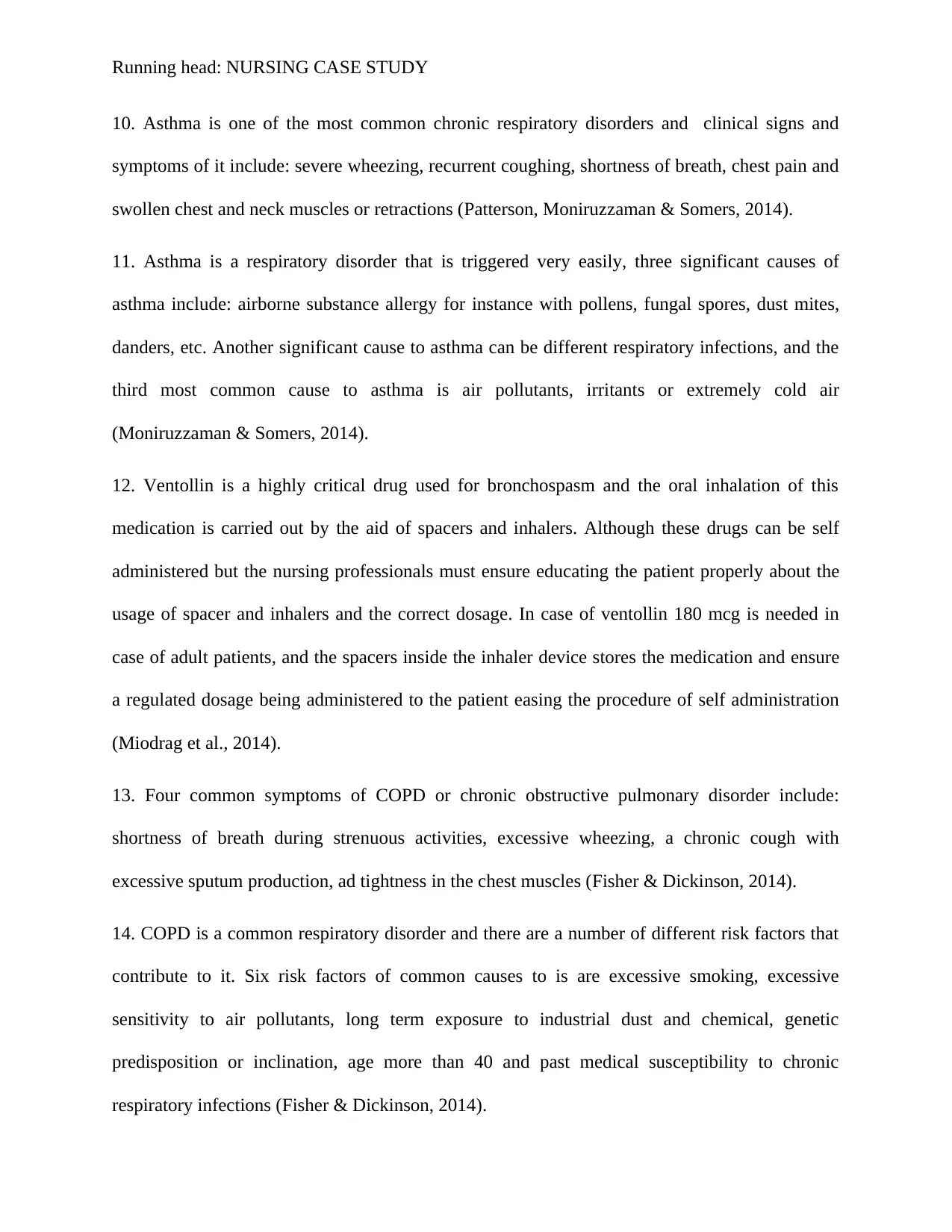
Running head: NURSING CASE STUDY
10. Asthma is one of the most common chronic respiratory disorders and clinical signs and
symptoms of it include: severe wheezing, recurrent coughing, shortness of breath, chest pain and
swollen chest and neck muscles or retractions (Patterson, Moniruzzaman & Somers, 2014).
11. Asthma is a respiratory disorder that is triggered very easily, three significant causes of
asthma include: airborne substance allergy for instance with pollens, fungal spores, dust mites,
danders, etc. Another significant cause to asthma can be different respiratory infections, and the
third most common cause to asthma is air pollutants, irritants or extremely cold air
(Moniruzzaman & Somers, 2014).
12. Ventollin is a highly critical drug used for bronchospasm and the oral inhalation of this
medication is carried out by the aid of spacers and inhalers. Although these drugs can be self
administered but the nursing professionals must ensure educating the patient properly about the
usage of spacer and inhalers and the correct dosage. In case of ventollin 180 mcg is needed in
case of adult patients, and the spacers inside the inhaler device stores the medication and ensure
a regulated dosage being administered to the patient easing the procedure of self administration
(Miodrag et al., 2014).
13. Four common symptoms of COPD or chronic obstructive pulmonary disorder include:
shortness of breath during strenuous activities, excessive wheezing, a chronic cough with
excessive sputum production, ad tightness in the chest muscles (Fisher & Dickinson, 2014).
14. COPD is a common respiratory disorder and there are a number of different risk factors that
contribute to it. Six risk factors of common causes to is are excessive smoking, excessive
sensitivity to air pollutants, long term exposure to industrial dust and chemical, genetic
predisposition or inclination, age more than 40 and past medical susceptibility to chronic
respiratory infections (Fisher & Dickinson, 2014).
10. Asthma is one of the most common chronic respiratory disorders and clinical signs and
symptoms of it include: severe wheezing, recurrent coughing, shortness of breath, chest pain and
swollen chest and neck muscles or retractions (Patterson, Moniruzzaman & Somers, 2014).
11. Asthma is a respiratory disorder that is triggered very easily, three significant causes of
asthma include: airborne substance allergy for instance with pollens, fungal spores, dust mites,
danders, etc. Another significant cause to asthma can be different respiratory infections, and the
third most common cause to asthma is air pollutants, irritants or extremely cold air
(Moniruzzaman & Somers, 2014).
12. Ventollin is a highly critical drug used for bronchospasm and the oral inhalation of this
medication is carried out by the aid of spacers and inhalers. Although these drugs can be self
administered but the nursing professionals must ensure educating the patient properly about the
usage of spacer and inhalers and the correct dosage. In case of ventollin 180 mcg is needed in
case of adult patients, and the spacers inside the inhaler device stores the medication and ensure
a regulated dosage being administered to the patient easing the procedure of self administration
(Miodrag et al., 2014).
13. Four common symptoms of COPD or chronic obstructive pulmonary disorder include:
shortness of breath during strenuous activities, excessive wheezing, a chronic cough with
excessive sputum production, ad tightness in the chest muscles (Fisher & Dickinson, 2014).
14. COPD is a common respiratory disorder and there are a number of different risk factors that
contribute to it. Six risk factors of common causes to is are excessive smoking, excessive
sensitivity to air pollutants, long term exposure to industrial dust and chemical, genetic
predisposition or inclination, age more than 40 and past medical susceptibility to chronic
respiratory infections (Fisher & Dickinson, 2014).

Running head: NURSING CASE STUDY
15. Cardiac dysfunction is one of the most common age related medical complication which is
seen very frequently in middle aged men and women. The common diagnostic tests that are
performed while assessing a cardiac dysfunction include: physical examination is the first step
where the patient will be checked thoroughly for signs of any physical manifestation of clinical
complications. The second set of tests is blood tests followed by regular chest Xrays. The fourth
test performed on a cardiac patient is electrocardiogram or ECG, which is theb most common
test for cardiac disorders, which shoes the ventricles in detail or any abnormality. The fifth test
preformed are echocardiography which provides more details on the interior of heart ventricles
and muscles, and the sixth is the magnetic resonance imaging or MRI which shows the internal
structures of the heart in acute details (Henry & Schor, 2015).
16. 4 risk factors for stroke are smoking, high blood pressure, diabetes, and aging (Chiauzzi,
Rodarte & DasMahapatra, 2015).
17. Rheumatoid arthritis: It is an autoimmune disease causing chronic inflammation of the joints
and extreme pain and other discomfort.
Ankylosing spondylitis: it is a type of the arthritis of the spine causing extreme pain and
stiffness along the spine.
Gout: Gout is a type of arthritis caused by the accumulation of uric acid crystals in the joints
(Lorig et al., 2014).
15. Cardiac dysfunction is one of the most common age related medical complication which is
seen very frequently in middle aged men and women. The common diagnostic tests that are
performed while assessing a cardiac dysfunction include: physical examination is the first step
where the patient will be checked thoroughly for signs of any physical manifestation of clinical
complications. The second set of tests is blood tests followed by regular chest Xrays. The fourth
test performed on a cardiac patient is electrocardiogram or ECG, which is theb most common
test for cardiac disorders, which shoes the ventricles in detail or any abnormality. The fifth test
preformed are echocardiography which provides more details on the interior of heart ventricles
and muscles, and the sixth is the magnetic resonance imaging or MRI which shows the internal
structures of the heart in acute details (Henry & Schor, 2015).
16. 4 risk factors for stroke are smoking, high blood pressure, diabetes, and aging (Chiauzzi,
Rodarte & DasMahapatra, 2015).
17. Rheumatoid arthritis: It is an autoimmune disease causing chronic inflammation of the joints
and extreme pain and other discomfort.
Ankylosing spondylitis: it is a type of the arthritis of the spine causing extreme pain and
stiffness along the spine.
Gout: Gout is a type of arthritis caused by the accumulation of uric acid crystals in the joints
(Lorig et al., 2014).
⊘ This is a preview!⊘
Do you want full access?
Subscribe today to unlock all pages.

Trusted by 1+ million students worldwide
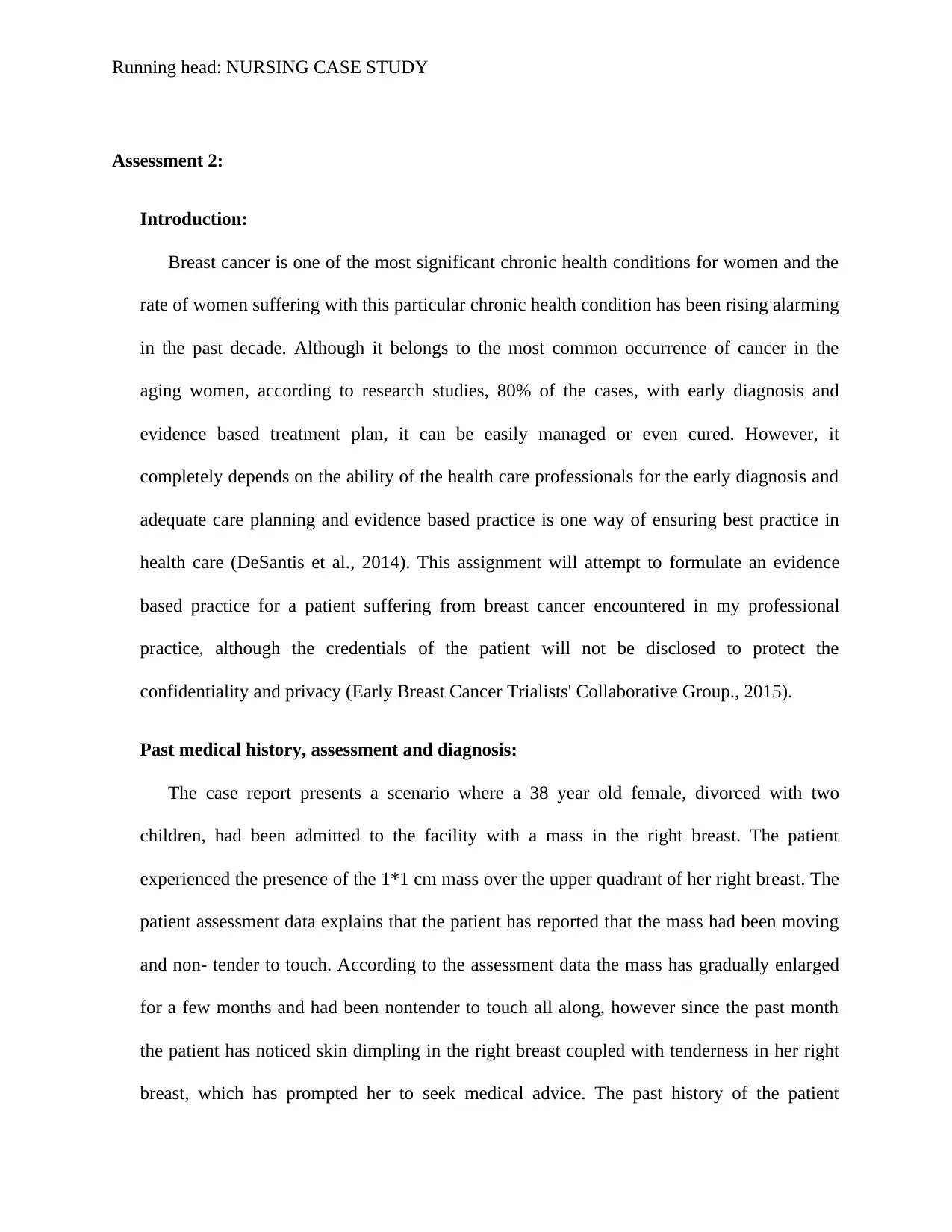
Running head: NURSING CASE STUDY
Assessment 2:
Introduction:
Breast cancer is one of the most significant chronic health conditions for women and the
rate of women suffering with this particular chronic health condition has been rising alarming
in the past decade. Although it belongs to the most common occurrence of cancer in the
aging women, according to research studies, 80% of the cases, with early diagnosis and
evidence based treatment plan, it can be easily managed or even cured. However, it
completely depends on the ability of the health care professionals for the early diagnosis and
adequate care planning and evidence based practice is one way of ensuring best practice in
health care (DeSantis et al., 2014). This assignment will attempt to formulate an evidence
based practice for a patient suffering from breast cancer encountered in my professional
practice, although the credentials of the patient will not be disclosed to protect the
confidentiality and privacy (Early Breast Cancer Trialists' Collaborative Group., 2015).
Past medical history, assessment and diagnosis:
The case report presents a scenario where a 38 year old female, divorced with two
children, had been admitted to the facility with a mass in the right breast. The patient
experienced the presence of the 1*1 cm mass over the upper quadrant of her right breast. The
patient assessment data explains that the patient has reported that the mass had been moving
and non- tender to touch. According to the assessment data the mass has gradually enlarged
for a few months and had been nontender to touch all along, however since the past month
the patient has noticed skin dimpling in the right breast coupled with tenderness in her right
breast, which has prompted her to seek medical advice. The past history of the patient
Assessment 2:
Introduction:
Breast cancer is one of the most significant chronic health conditions for women and the
rate of women suffering with this particular chronic health condition has been rising alarming
in the past decade. Although it belongs to the most common occurrence of cancer in the
aging women, according to research studies, 80% of the cases, with early diagnosis and
evidence based treatment plan, it can be easily managed or even cured. However, it
completely depends on the ability of the health care professionals for the early diagnosis and
adequate care planning and evidence based practice is one way of ensuring best practice in
health care (DeSantis et al., 2014). This assignment will attempt to formulate an evidence
based practice for a patient suffering from breast cancer encountered in my professional
practice, although the credentials of the patient will not be disclosed to protect the
confidentiality and privacy (Early Breast Cancer Trialists' Collaborative Group., 2015).
Past medical history, assessment and diagnosis:
The case report presents a scenario where a 38 year old female, divorced with two
children, had been admitted to the facility with a mass in the right breast. The patient
experienced the presence of the 1*1 cm mass over the upper quadrant of her right breast. The
patient assessment data explains that the patient has reported that the mass had been moving
and non- tender to touch. According to the assessment data the mass has gradually enlarged
for a few months and had been nontender to touch all along, however since the past month
the patient has noticed skin dimpling in the right breast coupled with tenderness in her right
breast, which has prompted her to seek medical advice. The past history of the patient
Paraphrase This Document
Need a fresh take? Get an instant paraphrase of this document with our AI Paraphraser

Running head: NURSING CASE STUDY
includes cardiac distress and excessive smoking and anxiety attacks, although she had been
under any heavy medication dosage (Cortazar et al., 2014). The patient is not an alcoholic
and her menstruation cycles had been consistent as well with no major trauma in the past.
The family history indicates mortality in the bloodline of her mother due to right breast
cancer and her signs and symptoms also indicate at breast malignancy. For further
confirmation that patient had been advised to go through a few diagnostic tests like
mammogram and biopsy. Diagnostic mammography will help in discovering subtle
abnormalities in the suspected site before the biopsy is performed. The excision biopsy
revealed a 3*2.5cm mass in the right breast of the patient indicating at the presence of
invasive ductal carcinoma (Wolff et al., 2013).
Clinical manifestation:
Invasive ductal carcinoma is considered to be one of the most common type of braest
cancers frequently seen in women. In this type the abnormal cell growth priginates inthe milk
duct and it gradually breaks through the walls and invade the rest of the breast tissues.
Although, the proliferating cells may stay localized or they may move around in the body
spreading the cancer everywhere, a pursuit usually in the later stages of the carcinoma. The
clinical manifestation of this particular carcinoma includes the formation of a lump or
thickening in the breast tissues which may appear like a hard rounded mass of cells to touch.
The manifestation escalates within a few months by changes in the shape and size of the
breast affected and increasing tenderness to the tissue (Goldhirsch et al., 2013). The clinical
manifestations continue with the secretion of a clear or blood stained exudates from the
nipple and the presence of skin dimpling, presence of scaly tissues or inflammation is also
common occurrence, although it had been absent in case of the patient under consideration in
includes cardiac distress and excessive smoking and anxiety attacks, although she had been
under any heavy medication dosage (Cortazar et al., 2014). The patient is not an alcoholic
and her menstruation cycles had been consistent as well with no major trauma in the past.
The family history indicates mortality in the bloodline of her mother due to right breast
cancer and her signs and symptoms also indicate at breast malignancy. For further
confirmation that patient had been advised to go through a few diagnostic tests like
mammogram and biopsy. Diagnostic mammography will help in discovering subtle
abnormalities in the suspected site before the biopsy is performed. The excision biopsy
revealed a 3*2.5cm mass in the right breast of the patient indicating at the presence of
invasive ductal carcinoma (Wolff et al., 2013).
Clinical manifestation:
Invasive ductal carcinoma is considered to be one of the most common type of braest
cancers frequently seen in women. In this type the abnormal cell growth priginates inthe milk
duct and it gradually breaks through the walls and invade the rest of the breast tissues.
Although, the proliferating cells may stay localized or they may move around in the body
spreading the cancer everywhere, a pursuit usually in the later stages of the carcinoma. The
clinical manifestation of this particular carcinoma includes the formation of a lump or
thickening in the breast tissues which may appear like a hard rounded mass of cells to touch.
The manifestation escalates within a few months by changes in the shape and size of the
breast affected and increasing tenderness to the tissue (Goldhirsch et al., 2013). The clinical
manifestations continue with the secretion of a clear or blood stained exudates from the
nipple and the presence of skin dimpling, presence of scaly tissues or inflammation is also
common occurrence, although it had been absent in case of the patient under consideration in
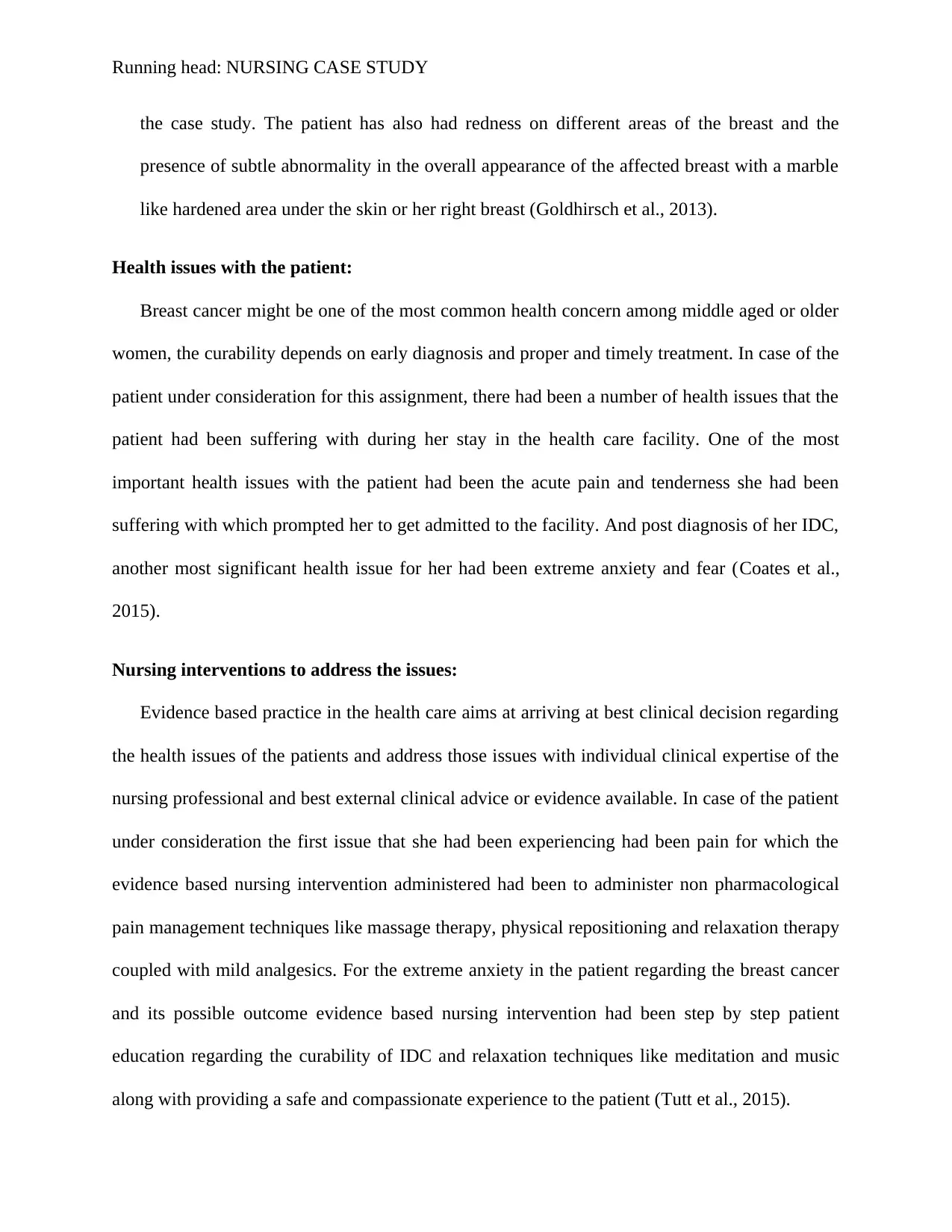
Running head: NURSING CASE STUDY
the case study. The patient has also had redness on different areas of the breast and the
presence of subtle abnormality in the overall appearance of the affected breast with a marble
like hardened area under the skin or her right breast (Goldhirsch et al., 2013).
Health issues with the patient:
Breast cancer might be one of the most common health concern among middle aged or older
women, the curability depends on early diagnosis and proper and timely treatment. In case of the
patient under consideration for this assignment, there had been a number of health issues that the
patient had been suffering with during her stay in the health care facility. One of the most
important health issues with the patient had been the acute pain and tenderness she had been
suffering with which prompted her to get admitted to the facility. And post diagnosis of her IDC,
another most significant health issue for her had been extreme anxiety and fear (Coates et al.,
2015).
Nursing interventions to address the issues:
Evidence based practice in the health care aims at arriving at best clinical decision regarding
the health issues of the patients and address those issues with individual clinical expertise of the
nursing professional and best external clinical advice or evidence available. In case of the patient
under consideration the first issue that she had been experiencing had been pain for which the
evidence based nursing intervention administered had been to administer non pharmacological
pain management techniques like massage therapy, physical repositioning and relaxation therapy
coupled with mild analgesics. For the extreme anxiety in the patient regarding the breast cancer
and its possible outcome evidence based nursing intervention had been step by step patient
education regarding the curability of IDC and relaxation techniques like meditation and music
along with providing a safe and compassionate experience to the patient (Tutt et al., 2015).
the case study. The patient has also had redness on different areas of the breast and the
presence of subtle abnormality in the overall appearance of the affected breast with a marble
like hardened area under the skin or her right breast (Goldhirsch et al., 2013).
Health issues with the patient:
Breast cancer might be one of the most common health concern among middle aged or older
women, the curability depends on early diagnosis and proper and timely treatment. In case of the
patient under consideration for this assignment, there had been a number of health issues that the
patient had been suffering with during her stay in the health care facility. One of the most
important health issues with the patient had been the acute pain and tenderness she had been
suffering with which prompted her to get admitted to the facility. And post diagnosis of her IDC,
another most significant health issue for her had been extreme anxiety and fear (Coates et al.,
2015).
Nursing interventions to address the issues:
Evidence based practice in the health care aims at arriving at best clinical decision regarding
the health issues of the patients and address those issues with individual clinical expertise of the
nursing professional and best external clinical advice or evidence available. In case of the patient
under consideration the first issue that she had been experiencing had been pain for which the
evidence based nursing intervention administered had been to administer non pharmacological
pain management techniques like massage therapy, physical repositioning and relaxation therapy
coupled with mild analgesics. For the extreme anxiety in the patient regarding the breast cancer
and its possible outcome evidence based nursing intervention had been step by step patient
education regarding the curability of IDC and relaxation techniques like meditation and music
along with providing a safe and compassionate experience to the patient (Tutt et al., 2015).
⊘ This is a preview!⊘
Do you want full access?
Subscribe today to unlock all pages.

Trusted by 1+ million students worldwide
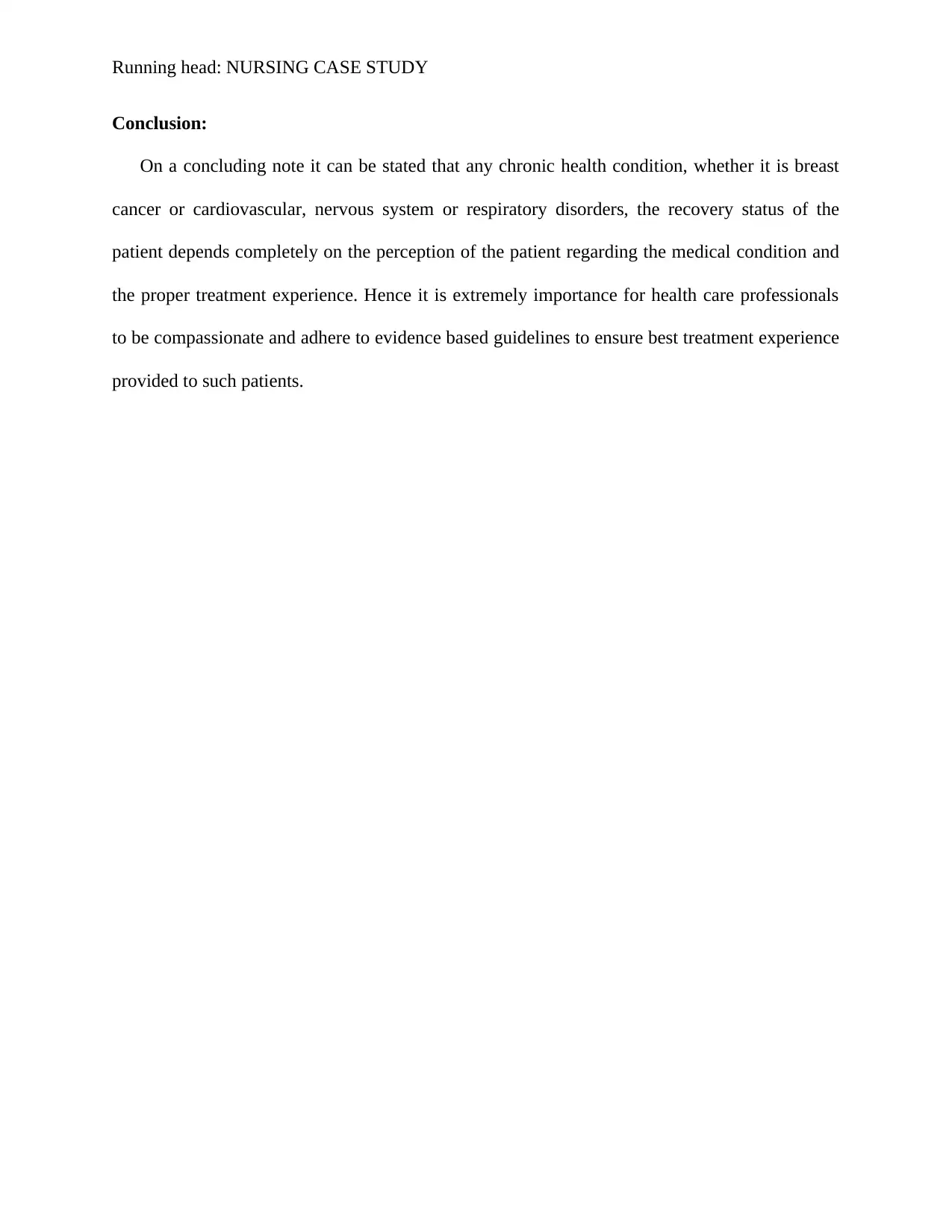
Running head: NURSING CASE STUDY
Conclusion:
On a concluding note it can be stated that any chronic health condition, whether it is breast
cancer or cardiovascular, nervous system or respiratory disorders, the recovery status of the
patient depends completely on the perception of the patient regarding the medical condition and
the proper treatment experience. Hence it is extremely importance for health care professionals
to be compassionate and adhere to evidence based guidelines to ensure best treatment experience
provided to such patients.
Conclusion:
On a concluding note it can be stated that any chronic health condition, whether it is breast
cancer or cardiovascular, nervous system or respiratory disorders, the recovery status of the
patient depends completely on the perception of the patient regarding the medical condition and
the proper treatment experience. Hence it is extremely importance for health care professionals
to be compassionate and adhere to evidence based guidelines to ensure best treatment experience
provided to such patients.
Paraphrase This Document
Need a fresh take? Get an instant paraphrase of this document with our AI Paraphraser
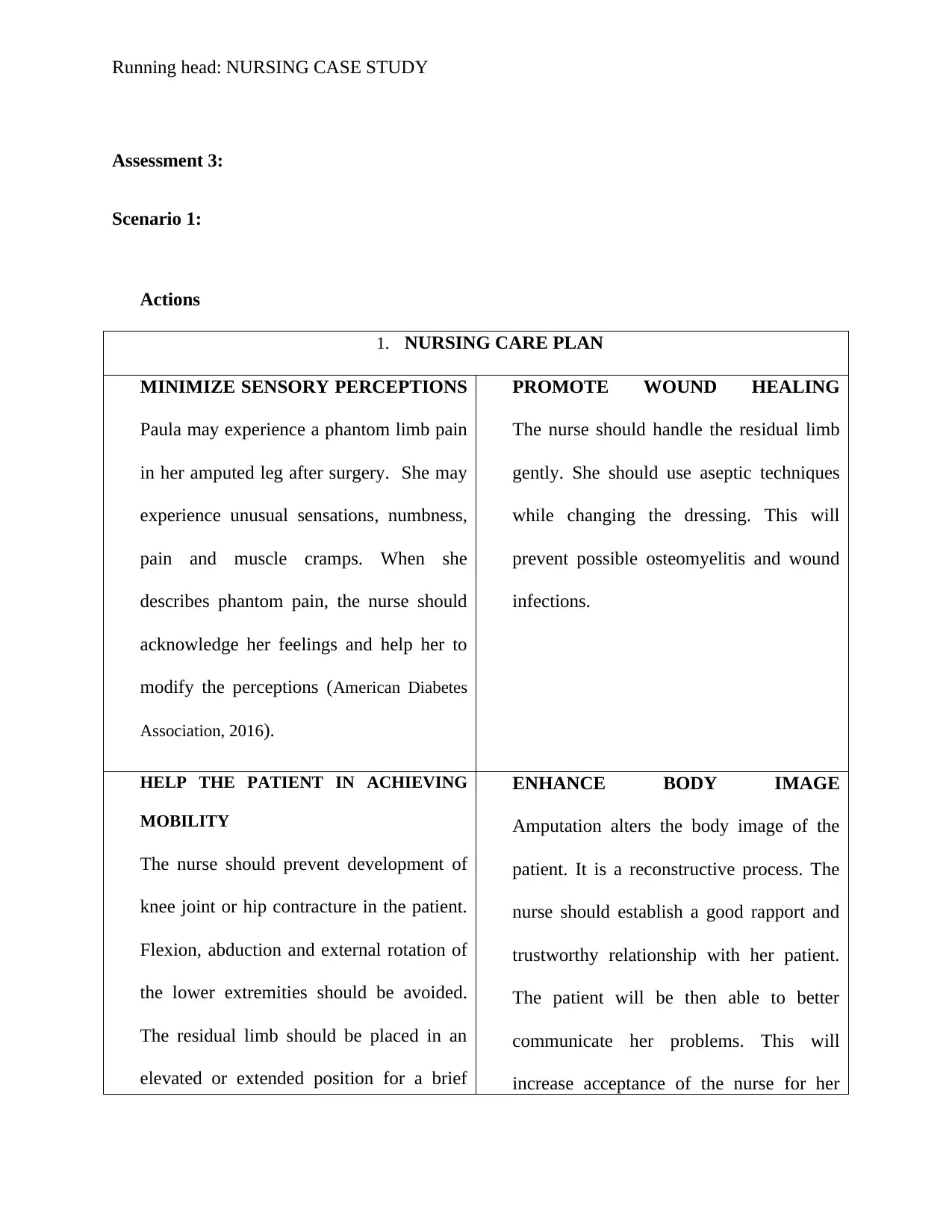
Running head: NURSING CASE STUDY
Assessment 3:
Scenario 1:
Actions
1. NURSING CARE PLAN
MINIMIZE SENSORY PERCEPTIONS
Paula may experience a phantom limb pain
in her amputed leg after surgery. She may
experience unusual sensations, numbness,
pain and muscle cramps. When she
describes phantom pain, the nurse should
acknowledge her feelings and help her to
modify the perceptions (American Diabetes
Association, 2016).
PROMOTE WOUND HEALING
The nurse should handle the residual limb
gently. She should use aseptic techniques
while changing the dressing. This will
prevent possible osteomyelitis and wound
infections.
HELP THE PATIENT IN ACHIEVING
MOBILITY
The nurse should prevent development of
knee joint or hip contracture in the patient.
Flexion, abduction and external rotation of
the lower extremities should be avoided.
The residual limb should be placed in an
elevated or extended position for a brief
ENHANCE BODY IMAGE
Amputation alters the body image of the
patient. It is a reconstructive process. The
nurse should establish a good rapport and
trustworthy relationship with her patient.
The patient will be then able to better
communicate her problems. This will
increase acceptance of the nurse for her
Assessment 3:
Scenario 1:
Actions
1. NURSING CARE PLAN
MINIMIZE SENSORY PERCEPTIONS
Paula may experience a phantom limb pain
in her amputed leg after surgery. She may
experience unusual sensations, numbness,
pain and muscle cramps. When she
describes phantom pain, the nurse should
acknowledge her feelings and help her to
modify the perceptions (American Diabetes
Association, 2016).
PROMOTE WOUND HEALING
The nurse should handle the residual limb
gently. She should use aseptic techniques
while changing the dressing. This will
prevent possible osteomyelitis and wound
infections.
HELP THE PATIENT IN ACHIEVING
MOBILITY
The nurse should prevent development of
knee joint or hip contracture in the patient.
Flexion, abduction and external rotation of
the lower extremities should be avoided.
The residual limb should be placed in an
elevated or extended position for a brief
ENHANCE BODY IMAGE
Amputation alters the body image of the
patient. It is a reconstructive process. The
nurse should establish a good rapport and
trustworthy relationship with her patient.
The patient will be then able to better
communicate her problems. This will
increase acceptance of the nurse for her
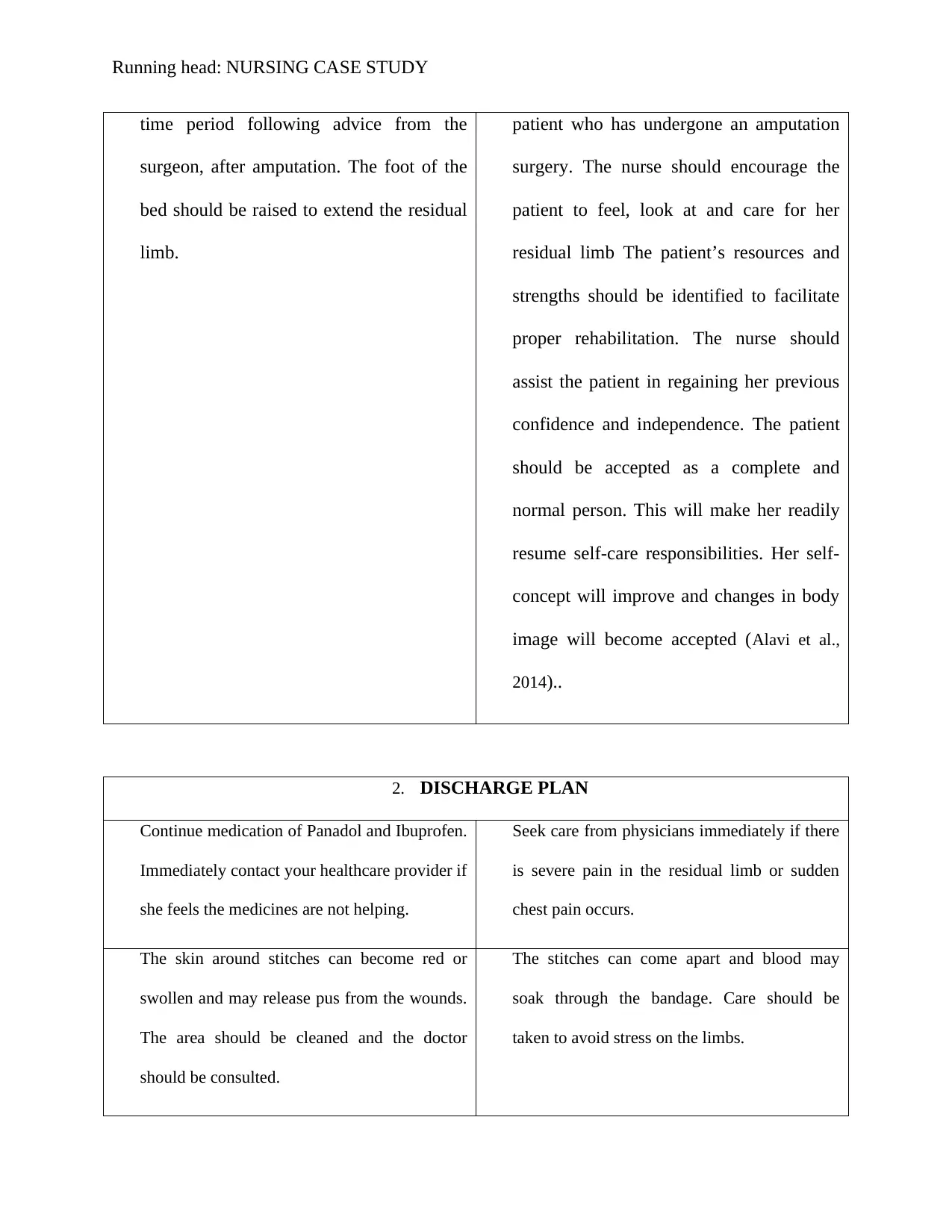
Running head: NURSING CASE STUDY
time period following advice from the
surgeon, after amputation. The foot of the
bed should be raised to extend the residual
limb.
patient who has undergone an amputation
surgery. The nurse should encourage the
patient to feel, look at and care for her
residual limb The patient’s resources and
strengths should be identified to facilitate
proper rehabilitation. The nurse should
assist the patient in regaining her previous
confidence and independence. The patient
should be accepted as a complete and
normal person. This will make her readily
resume self-care responsibilities. Her self-
concept will improve and changes in body
image will become accepted (Alavi et al.,
2014)..
2. DISCHARGE PLAN
Continue medication of Panadol and Ibuprofen.
Immediately contact your healthcare provider if
she feels the medicines are not helping.
Seek care from physicians immediately if there
is severe pain in the residual limb or sudden
chest pain occurs.
The skin around stitches can become red or
swollen and may release pus from the wounds.
The area should be cleaned and the doctor
should be consulted.
The stitches can come apart and blood may
soak through the bandage. Care should be
taken to avoid stress on the limbs.
time period following advice from the
surgeon, after amputation. The foot of the
bed should be raised to extend the residual
limb.
patient who has undergone an amputation
surgery. The nurse should encourage the
patient to feel, look at and care for her
residual limb The patient’s resources and
strengths should be identified to facilitate
proper rehabilitation. The nurse should
assist the patient in regaining her previous
confidence and independence. The patient
should be accepted as a complete and
normal person. This will make her readily
resume self-care responsibilities. Her self-
concept will improve and changes in body
image will become accepted (Alavi et al.,
2014)..
2. DISCHARGE PLAN
Continue medication of Panadol and Ibuprofen.
Immediately contact your healthcare provider if
she feels the medicines are not helping.
Seek care from physicians immediately if there
is severe pain in the residual limb or sudden
chest pain occurs.
The skin around stitches can become red or
swollen and may release pus from the wounds.
The area should be cleaned and the doctor
should be consulted.
The stitches can come apart and blood may
soak through the bandage. Care should be
taken to avoid stress on the limbs.
⊘ This is a preview!⊘
Do you want full access?
Subscribe today to unlock all pages.

Trusted by 1+ million students worldwide
1 out of 23
Related Documents
Your All-in-One AI-Powered Toolkit for Academic Success.
+13062052269
info@desklib.com
Available 24*7 on WhatsApp / Email
![[object Object]](/_next/static/media/star-bottom.7253800d.svg)
Unlock your academic potential
Copyright © 2020–2025 A2Z Services. All Rights Reserved. Developed and managed by ZUCOL.





